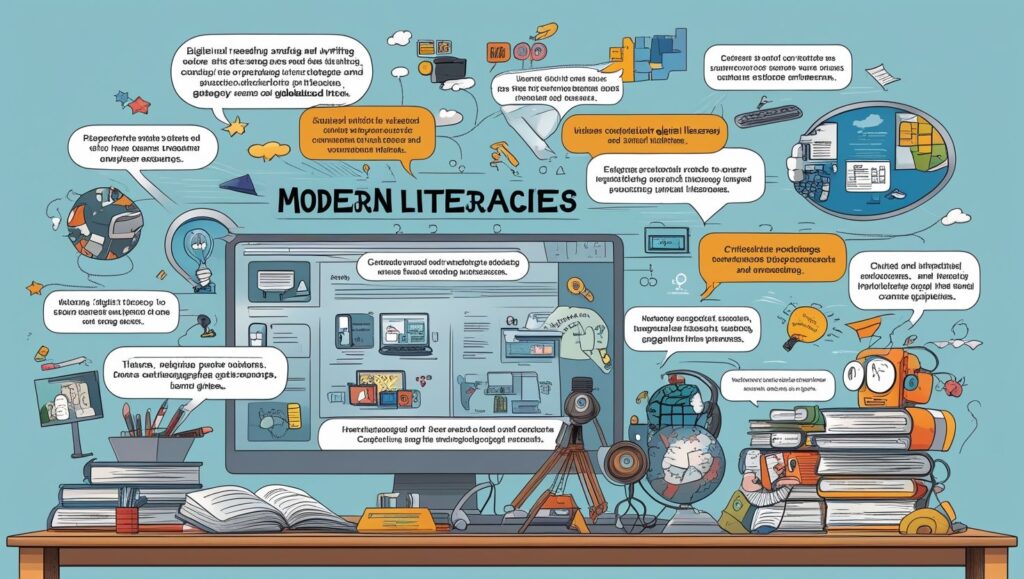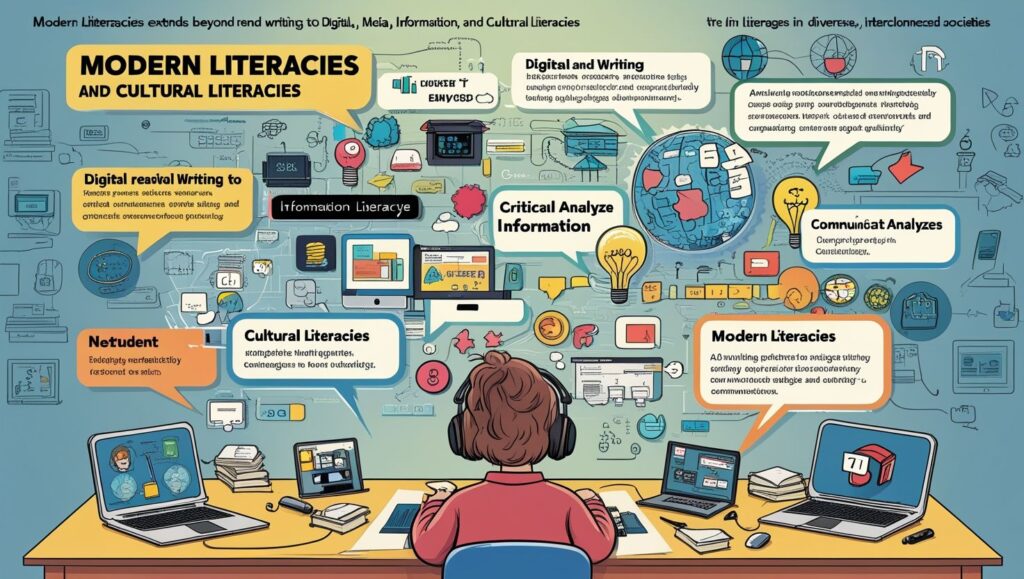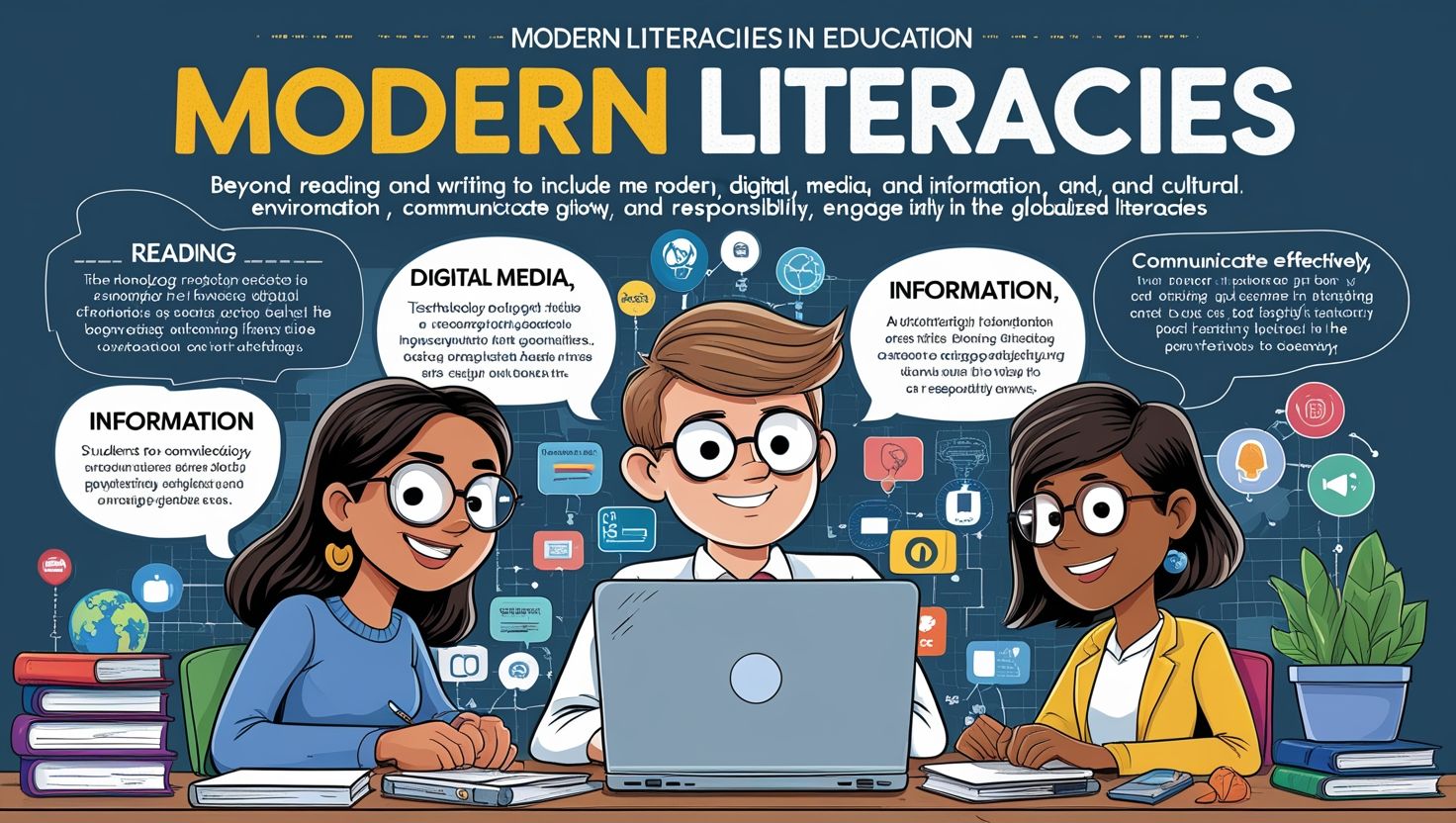Introduction
Modern Types of Literacies in Education, In the 21st century, the concept of literacy has expanded far beyond the traditional ability to read and write. With rapid technological advancements, globalization, and evolving societal needs, new forms of literacy have emerged to equip individuals with the necessary skills to navigate an increasingly complex world. Modern literacies encompass a wide range of competencies, from digital and media literacy to financial and emotional literacy.
This article explores the various modern types of literacies in education, their significance, and how they are shaping learning in the digital age.
1. Digital Literacy
Definition and Importance
Digital literacy refers to the ability to use technology effectively to find, evaluate, create, and communicate information. It includes skills such as using software, understanding digital security, and navigating online platforms responsibly.
In today’s education system, digital literacy is crucial because:
- It enhances learning through interactive and multimedia resources.
- It prepares students for a workforce dominated by technology.
- It promotes safe and ethical internet usage.
Components of Digital Literacy
- Technical Skills: Operating devices, using software, and troubleshooting basic tech issues.
- Information Literacy: Assessing the credibility of online sources.
- Communication Skills: Engaging in digital discussions via email, social media, and collaborative platforms.
- Cybersecurity Awareness: Understanding privacy settings, avoiding scams, and protecting personal data.
Implementation in Education
Schools integrate digital literacy through:
- Coding and programming courses.
- Online research projects.
- Digital citizenship programs.
2. Media Literacy
Definition and Importance
Media literacy involves the ability to critically analyze and interpret media messages, including news, advertisements, and social media content. It helps individuals distinguish between factual information and misinformation.
Key reasons for its importance:
- Combats fake news and propaganda.
- Encourages informed decision-making.
- Develops critical thinking skills.
Components of Media Literacy
- Understanding Media Bias: Recognizing how media outlets may present information selectively.
- Analyzing Visual and Textual Messages: Interpreting symbols, stereotypes, and persuasive techniques.
- Creating Responsible Media: Learning to produce ethical and accurate content.
Implementation in Education
- Teaching students to fact-check sources.
- Discussing case studies of media manipulation.
- Encouraging student journalism and content creation.
3. Financial Literacy
Definition and Importance
Financial literacy is the ability to manage personal finances effectively, including budgeting, saving, investing, and understanding credit.
Why it matters:
- Reduces personal debt and financial instability.
- Prepares students for real-world economic challenges.
- Encourages responsible spending and investment habits.
Key Concepts in Financial Literacy
- Budgeting and Saving: Tracking income and expenses.
- Understanding Credit and Loans: How interest rates work.
- Investing Basics: Stocks, bonds, and retirement planning.
Implementation in Education
- Incorporating financial literacy into math and economics curricula.
- Simulations like stock market games.
- Guest lectures from financial experts.

4. Emotional Literacy (Social-Emotional Learning – SEL)
Definition and Importance
Emotional literacy refers to the ability to recognize, understand, and manage one’s emotions while empathizing with others. It is a key component of Social-Emotional Learning (SEL).
Benefits include:
- Improved mental health and well-being.
- Better conflict resolution and teamwork.
- Enhanced academic performance through reduced stress.
Components of Emotional Literacy
- Self-Awareness: Identifying personal emotions and triggers.
- Self-Regulation: Managing emotions constructively.
- Empathy: Understanding others’ feelings.
- Relationship Skills: Building healthy social connections.
Implementation in Education
- SEL programs in schools.
- Mindfulness and meditation exercises.
- Role-playing scenarios for conflict resolution.
5. Global Literacy (Cultural Literacy)
Definition and Importance
Global literacy involves understanding diverse cultures, global issues, and international perspectives. It fosters tolerance and collaboration in a multicultural world.
Why it’s essential:
- Prepares students for global careers.
- Promotes inclusivity and reduces prejudice.
- Encourages awareness of global challenges like climate change and human rights.
Key Aspects of Global Literacy
- Cultural Awareness: Learning about traditions, languages, and histories of different societies.
- Global Citizenship: Understanding one’s role in addressing worldwide issues.
- Cross-Cultural Communication: Effective interaction in diverse settings.
Implementation in Education
- Exchange programs and multicultural events.
- Studying international case studies in social sciences.
- Collaborative projects with schools in other countries.
6. Environmental Literacy
Definition and Importance
Environmental literacy is the understanding of ecological systems and sustainable practices to address environmental challenges.
Its significance lies in:
- Encouraging eco-friendly behaviors.
- Raising awareness about climate change.
- Promoting conservation efforts.
Key Concepts in Environmental Literacy
- Ecosystems and Biodiversity: Understanding natural habitats.
- Sustainability: Reducing waste, recycling, and renewable energy.
- Climate Change Science: Causes, effects, and solutions.
Implementation in Education
- School recycling programs.
- Field trips to nature reserves.
- Project-based learning on sustainability.

7. Health Literacy
Definition and Importance
Health literacy is the ability to access, understand, and apply health-related information for well-being.
Why it’s crucial:
- Empowers individuals to make informed health decisions.
- Reduces misinformation about diseases and treatments.
- Promotes preventive healthcare.
Components of Health Literacy
- Nutritional Knowledge: Understanding balanced diets.
- Mental Health Awareness: Recognizing signs of stress and depression.
- Medical Literacy: Interpreting prescriptions and healthcare advice.
Implementation in Education
- Health and wellness programs in schools.
- Workshops on mental health and stress management.
- Physical education with a focus on lifelong fitness.
8. Civic Literacy
Definition and Importance
Civic literacy involves understanding governmental systems, rights, and responsibilities as a citizen.
Its importance includes:
- Encouraging informed voting and political participation.
- Fostering community engagement.
- Promoting justice and equality.
Key Aspects of Civic Literacy
- Government Structure: How laws are made and enforced.
- Civil Rights and Duties: Freedom of speech, voting, and jury service.
- Current Events Analysis: Connecting classroom learning to real-world politics.
Implementation in Education
- Mock elections and debates.
- Community service projects.
- Studying historical movements for social change.
Conclusion
Modern literacies extend beyond traditional reading and writing to encompass a wide range of skills necessary for success in today’s interconnected world. From digital and media literacy to financial and emotional intelligence, these competencies prepare students to thrive academically, professionally, and personally.
Educational institutions must continue integrating these literacies into curricula to ensure learners are well-equipped for future challenges. By fostering these diverse skills, we cultivate not only knowledgeable individuals but also responsible global citizens capable of critical thinking, empathy, and innovation.

Puraburn Hi there to all, for the reason that I am genuinely keen of reading this website’s post to be updated on a regular basis. It carries pleasant stuff.
Hi, Neat post. There is a problem with your site in internet explorer, would check this… IE still is the market leader and a good portion of people will miss your magnificent writing due to this problem.
knj7gs
Wake up your way with this premium CD player alarm clock radio. Whether you prefer to rise with the AM/FM radio, your favorite CD, or a standard buzzer, this versatile alarm clock with CD player has you covered. Its intuitive design includes dual alarms, a large digital display, snooze/sleep timers, and USB charging for your phone. Enjoy high-quality stereo sound from a compact unit that fits easily on any bedside table or shelf. The best clock radios with CD player combine retro functionality with modern convenience—and this one leads the pack.
Hi, after reading this amazing post i am also delighted
to share my experience here with colleagues.
my page – nordvpn coupons inspiresensation
I want to get across my gratitude for your generosity giving support to those who absolutely need guidance on this important content. Your real commitment to getting the solution around appeared to be extremely helpful and have really enabled workers much like me to get to their pursuits. Your own insightful guidelines can mean so much to me and extremely more to my mates. Regards; from each one of us.
Hi are using WordPress for your blog platform? I’m new to the blog world but I’m trying to get started and set up my own. Do you require any coding knowledge to make your own blog? Any help would be greatly appreciated!